| |
|||||
The Polikarpov I-16 Fighter, Part I
| Update: This article has been updated with newer artwork and research. The original text will be left "as-is". This helps to track the progress of newer and better information, discoveries, and thoughts about VVS camouflage. Also it is fascinating to see how, or if, perceptions evolve. The updated text will appear in a box like this, and this should be seen when in contradiction to the original to be the correct current interpretation, supplanting the former. |
The Polikarpov I-16 Fighter
More than any other VVS fighter, the I-16 family of machines
seemed to have lent themselves to experimental camouflage and markings during
the 1930's. Perhaps the result of its curious, tubby, decoesque shape, or even
due to the fact that the I-16 was in production during the entire period of
Soviet camouflage experimentation, the explosion of unusual coloration on this
machine remains unprecedented.
Some examples of odd I-16 camouflage were indeed Officially
sponsored experiments, and a superb study of a few of these examples may be
found in Vakhlamov and Orlov's article on VVS camouflage (see M-Hobby Magazine
issue 1/99). Many examples, no doubt, were also applied by specific factories
under atypical conditions or by specific personnel, but to date no documentary
evidence of this behavior has yet emerged. The Regiments of the Naval Air Forces
(VVS-VMF) are, of course, well known for their extraordinary and unique camouflage
throughout the Patriotic War, but it is notable that the Army, too, applied
such curious schemes to the I-16, occasionally even at the Divisional level.
One can only imagine at a possible motive for these practices,
as there is certainly no written documentation explaining these schemes. Unit
élan and preference must have played a part, but it is extremely odd
to note that some of these schemes appeared at the moment of maximum duress
and difficulty, as the German Army moved through western Russia with the Red
Army in retreat. Why experiment with camouflage at this time? Were these schemes,
then, the product of unit application as a matter of 'practical' camouflage?
Did the Army schemes appear as a result of influence from Naval units as the
two shared airfields around Leningrad? What about the PVO? I'm afraid that the
sheer number of questions raised by these applications simply dwarfs the available
information, and so we will have to confine our examinations to the schemes
themselves, and merely wonder at their inception.
I-16 Type 28 "Red 1"
|
 |
This aircraft was photographed during the Summer of 1941 (see below) with a line-up of other extraordinary I-16s somewhere near Minsk. This aircraft is thought to have been in service with either the 161 or 163 IAP, the pilot being unknown.
"Red 1" was completed in a two-color AII scheme comprising Black applied over
Green with very angular and geometrically specific shapes. The demarcation between
the colors is quite sharp, and there is sufficient difference in weathering
between the Green and Black areas to indicate that this application was completed
after having left the factory. The cowling was completely black, perhaps recalling
the common pre-War I-16 color schemes, except over the lower surfaces which
were AII Blue. This fact may well indicate that the machine was completed at
the Factory in a common solid Green upper surface application, an idea supported
by the newer appearance of the black-painted areas.
I-16 Type 28 "White 54"
|
 |
This extraordinary machine was photographed along with "Red 1" above (which, see) during the Summer of 1941 in the Minsk area. As with "1", the pilot is unknown.
"54" again sports an AII Black application over AII Green, and similarly the
pattern of weathering demonstrates that these were probably not applied together.
The Black color has been executed here in a remarkable manner, almost as if
'chunks' of the scheme had been bitten away. As well, the exhaust ports have
been highlighted and filled with color, as has the cowl face. A second view
demonstrates that 'plain' national star markings are present in four positions:
tail/fin and wing lower surfaces. No view is available of the upper and starboard
surfaces, and so these must remain the subject of great speculation.
I-16 Type 27 "White 39"
|
 |
A third aircraft from the Minsk line-up is this unusual Type 27 wearing the tactical numeral "39". The pilot of this machine is unknown.
This aircraft may provide the best clues so far as to the original appearance of the I-16s in this line-up, for minus the Black trim (which was clearly not applied as a component of any camouflage scheme) "39" demonstrates a very typical Zavod 21 AII Green over Blue single-color scheme from 1940-41. It seems likely, upon reflection, that all of the machines in this photo were so delivered, and subsequently modified by the receiving Regiment in the field. In this case, the "artist" chose to apply AII Black as a sort of 'trim' color, somewhat like what was occasionally done in flying schools to I-16s (using white, red, and yellow). The use of the 'stencil' type numeral is quite unusual, and one wonders if this might have been the original style as delivered from the Factory.
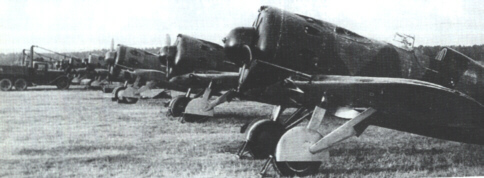
I-16 line-up near Minsk, thought to show the aircraft of the 161
or 163 IAP, ca. Summer 1941.
I-16 Type 28 "White 7"
|
 |
This aircraft was photographed also in service with the 13 IAP-KBF during the Winter of 1941-42, near Leningrad. The pilot is thought to be Aleksandr Mironenko [12+4 confirmed], an accomplished ace who flew sometimes as wingman to HSU Kovalev.
"7" seems to have been given a similar treatment to Romanenko's machine (see above), but the pattern of the Dark Green application leads one to wonder if this I-16 may not have been delivered in a two-color pattern originally? The 'scalloping' treatment applied to the cowling is quite unusual, and there is a small tactical numeral "4" rendered in red on the bottom of the rudder. The most remarkable aspect of the scheme, however, are the grey color applications on the wing upper surfaces, these again shown in AE-9 here.
An extensive series of photographs of "7" (and indeed, other machines of the
13 IAP-KBF) reside in the archival holdings of the Naval Museum, St.Peterburg,
but I do not yet have any of these pictures in my private collection. I hope
to publish one of these photos in my upcoming book.
| Unfortunately, the exact ownership of the I-16 remains a matter of uncertainty. It matches quite well some anecdotal evidence about Mironenko's Type 28, but no further concrete evidence has emerged. |
I-16 Type 17 "Black 6"
|
 |
This older Type 17 machine was photographed in service with the 71 IAP-KBF during the Winter of 1941 in the Leningrad region. The pilot is unknown [some sources have claimed that this aircraft is the mount of Aleksandr Baturin, but documents from the 71 IAP indicate that Baturin flew only I-153s at this time].
"Black 6" is one of the most debated of the curious Naval I-16s. On first glance, the aircraft seems to wear a heavily weathered pre-War AEh-9 finish on the upper surfaces, with AII Blue below. The red trim on the fin/rudder has been freshly applied, as has the neat non-bordered Kremlin Star on the fuselage. The number "6" also appears to be new, and the cowl band was left unpainted. However, I do not, for one, accept this interpretation.
The pre-War AEh-9 scheme was applied over the entire aircraft, not on the upper surfaces with AII lacquer below. I find it most unlikely that anyone would carefully apply AII Blue over the lower surfaces of this machine in the field, and in a manner exactly similar to the Factory treatment of the I-16. Moreover, why would the parties responsible for the extensive make-over of this machine (new and professionally applied trim, star, numeral) not also take the time to rectify its corroded surface finish, and only not so on the upper surfaces? It seems incongruous indeed to apply such smart trim to such a battered aircraft.
I believe that "Black 6" was the recipient of yet another Naval scheme of curious
innovation, this characterized by Medium Grey being applied in a 'wash', or
perhaps manually by brush, over a coat of AEh-9 grey. I think the original finish
was likely to have been AII Green over AII Blue, not a solid color AEh-9 scheme,
as proposed. It is even possible that various forms of MK-7 White distemper
with contaminant discoloration were used here, rather than grey colors; after
all, one might recall that the machine was photographed during the Winter. But,
it seems unlikely to me that such a neat job as this was the haphazard result
of weathering and re-painting. I find the argument much more convincing that
the VMF was experimenting with camouflage yet again here.
| This aircraft continues to fascinate, and the finish is a continuing matter of discussion. I would say that the best current interpretation is that the machine was originally finished in a more usual scheme, perhaps with a single-colour upper surface. This would appear to have been over-painted with AEh-9 lacquer, and then subsequently perhaps with MK-7 white. The resulting appearance could be the result of MK-7, heavily worn away from the surface. In any case, this scheme is quite remarkable. |
I-16 Type 17 "Red 8"
|
 |
This interesting Type 17 was photographed just after the outbreak of War on the Leningrad front during the summer of 1941. This aircraft was thought to be piloted by St.Lt. G. Zhuikov, 7 IAP, but it is possible that other unit pilots operated "8" as well.
The machine appears to have left Zavod 1 (Moscow, where it was manufactured)
in one of that factory's trademark Factory Green over AII Blue schemes. It then
seems that the scheme was modified--probably as a result of the 1940 Camouflage
Directive--with applications of AII Green. Curiously, the fairings over the
upper cowling ShKAS guns seem to have been unaffected by the re-painting job,
and perhaps were left aside during this process. The spinner has been removed
on "Red 8", and the propellor demonstrates considerable weathering. The tactical
numeral "8" is trimmed with a white outline, and there is a white flash along
the top of the fin/rudder. There is no view available of the upper surfaces
of this aircraft, and any re-coloration of those areas remains unknown.
| Oh dear... we can see that research has progressed much since the time of this writing, about seven years ago...! Of course, I-16 aircraft were not manufactured at Zavod 1; the scheme cannot be related to this factory as a result. It has since transpired that this finish, "Factory Green" (which is probably in fact AEh-15 lacquer), was indeed used most heavily at Zavod 1, but also on the I-16 programme at another factory as well, either Gor'ki or Novosibirsk. There are other examples, of the Type 29 for example, wearing this lacquer. Be that as it may, the rest of the details of "8" appear to be correct as shown. |
I-16 Type 17 "White 29"
|
 |
"29" was photographed in service with the 4 GIAP-KBF (Baltic Front) during the summer of 1942, and has been compared with Vasiliev's famous "White 28" machine of the same Regiment. The pilot of "29" is unknown.
Virtually every detail of "29" is remarkable in a way that begs for detailed examination. This aircraft shows unmistakable signs of considerable re-painting and wear. Most of the undersurface AII Blue color appears to be faded and worn, save for the tail wheel strut and horizontal stabilizers, which look freshly applied. Despite the fact that "29" most likely carried a simple AII Green/Blue scheme out of the Factory, the demarcation line on the fuselage is not consistent with any known Factory I-16 practice, being altogether too "messy". Furthermore, areas of the Green finish do not match in shade, though they do in fact match the known appearance of AII Green at different levels of wear. The cowling, fin/rudder, and stabilizers show an older, darkened appearance of AII Green, while the fuselage seems to demonstrate a newer, lighter version. This idea is also consistent with the strange appearance of the color demarcation line on the fuselage; it seems clear that this area has been re-painted sometime after the aircraft's original scheme.
The fin and rudder demonstrate what is probably a supplemental application of AII Black (noting that the pattern matches no other known I-16 Black/Green scheme) that seems to be very professionally applied, and with a nice hard demarcation line. The cowl and fuselage, however, have been over-sprayed with a very loose meandering Black application, somewhat reminding one of "28's" treatment. Also similarly, these patterns do not appear to continue--or "wrap"--very well over the top of the machine, probably having been applied by someone standing on the wing (or some such position).
The tactical numeral "29" is similar in style to that of Vasiliev's aircraft, but is smaller and more 'stencil-like' in appearance. Further, "29" features smaller, white-bordered national stars as compared to "28's" large, plain red style, and has no national insignia on the fin/rudder. "White 29" also features an inscription on the port side in yellow just aft of the star, "Za Rodinu!".
This machine is known from a single photograph in the collection of Mikhail
Abramovets, and no view is available of the starboard nor upper surfaces. I
hope to publish this photograph in my upcoming book.
I-16 Type 10 "White 15"
|

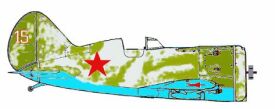 |
I-16 Type 10 number "15" was allegedly photographed in the summer of 1940, region unknown. The pilot of this machine is as yet unidentified. He appears to be an Army Leitant or St.Leitant, and wears an earlier style of cap giving one the impression that the photo might indeed have been taken in 1940-41.
"15" is quite interesting in that it is a very rare example of an I-16 in mottled scheme using what appears to be AEh-9 grey that is not in Navy service. It seems also safe to guess that this aircraft was originally delivered in a basic AII Green/Blue job, and modified subsequently with very soft and well-blended AEh-9 applications. The very nice appearance of the tactical numeral "15", trimmed in red, suggests that this marking is probably original from the Factory.
Three shots of "15" exist in the Dimitriev and Petrov collections, but alas
none show the upper nor port sides of the aircraft. This is especially disappointing
in that the port wing gives a tantalizing hint along the leading edge in the
shot below of what appears to be an absolutely unprecedented and extraordinary
striped color application on the upper surface involving very thin bands of
color. This application is unlike anything I have ever seen before on a VVS
machine, and must have been breathtaking to view in person.
I-16 Type 24 no number
|

|
This collection of five I-16 Type 24 aircraft is probably the most widely published photograph of the type in all of Western literature, and yet it remains one of the most quixotic, as well. Virtually nothing more is known about the origin nor placement of these fighters.
However, one new piece of evidence has emerged to shed a tiny glimmer of illumination
on what is a baffling puzzle--the origin of the photograph is now known. In
the basement of the Lenin Library, Moscow, a reel of 16mm film was discovered
that is unquestionably the 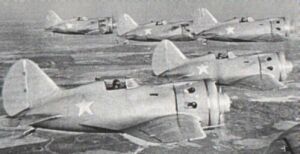 source
of these pictures. The film is a Government propaganda piece, shot by TASS and
intended for foreign distribution, dated 16 May 1941, and with the title, "The
Soviet Red Army Air Force Guards the Frontiers of the Motherland". This photo
is a still taken from the film, very near the beginning as it turns out.
source
of these pictures. The film is a Government propaganda piece, shot by TASS and
intended for foreign distribution, dated 16 May 1941, and with the title, "The
Soviet Red Army Air Force Guards the Frontiers of the Motherland". This photo
is a still taken from the film, very near the beginning as it turns out.
This fact sheds some light on the remarkable appearance of these machines. We know from other official Government photographs and films that the subject aircraft are usually well cleaned, and quite spiffy in appearance (as one would expect, really). These utterly immaculate I-16s are finished in an over-all AEh-9 scheme of a type that was by the time of their manufacture (late 1940, at earliest) out of use. Further, the national insignia have been rendered in AII Aluminum dope, and in the pre-War fashion of six locations (upper and lower wing, fuselage). Where the tactical numeral should appear, on the fin/rudder, there is nothing. Even the spinner has been beautifully done in this way, and the small joint between the two pieces has been polished, as have the propellor blades. And, lastly--and if this is not enough--the surface of these aircraft are unusually shiny, and I suspect the entire aircraft has been covered by an application of clear AII dope, a practice which was not unknown in the pre-War era.
The results, of course, are the magnificent machines we see in the photo. An
appearance not shared, by the way, by the photographing aircraft which was also
an I-16 (wearing green of some kind). Their utilization in a propaganda film
also explains the complete lack of tactical or regimental markings, and the
absence of any usual wear and tear as one would expect on a service fighter.
It explains, too, the curious paint scheme, one that was expressly countermanded
in the 1940 Camouflage Directive. Thus, and ironically, the appearance of the
Polikarpov I-16 most recognizable to the average Western observer is in fact
no more than a misleading and highly polished "film star" aircraft, having no
relation to the appearance of genuine combat machines in service with the VVS.
| Since the time of original writing, the origin of this aircraft has been revealed. These machines were indeed the very same tarted up ishaks appearing in the 16 May 1941 film. It is thought that six I-16 Type 24s were painted in this way, and that they belonged to the 178 IAP-PVO based south of Moscow. The film depicts a number of pilots having a 'briefing' prior to the flight, and the commanding officer in this shot is undoubtedly R. Rakov, the 178's Regimental Commander. There is no information available on what may have happened to these aircraft subsequently, but one doubts very much indeed if they might have remained in such a garrish livery in service. The finish is now thought in fact to be an over-all coat of AEh-8, not -9, which was slightly darker than the latter and more common paint (and also used by the aerobatic team based at the same airfield). |
I-16 Type 10 "Red 12"
|

|
"Red 12" was one of a line-up of I-16s photographed in service with an unknown unit on the Leningrad Front, ca. winter 1940-41. The service unit and pilots of these machines are unknown.
I have always been amused by V. Romanov's classic line describing this line-up photograph as the "Squadron of the Indecisive Camouflage". Certainly the description seems adequate, for the application and colors used here are indeed unique and unusual. The aircraft in question are all Type 10s with retractable ski undercarriages, and all of them appear to have been finished in a similar manner. Numbers "12, "9", "6", and "3" are visible in the shot.
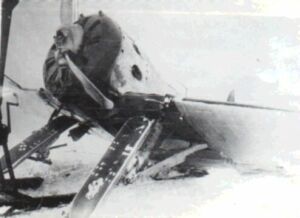 The
aircraft are covered with a thick--if not skillfully--applied coat of MK-7 White,
both on the upper and lower surfaces. Or, at least most of them. From the well-known
view, the cowl face and the upper surface of the wing outer panels are finished
in Black. Or, at least this seems most likely. Romanov claimed the paint was
Factory Green color, and while this is indeed plausible as per the appearance
of the machines in the photo, it does not seem likely to me that anyone outside
of Factory No.1 would have been able to obtain quantities of this paint, whereas
Black was entirely ubiquitous.
The
aircraft are covered with a thick--if not skillfully--applied coat of MK-7 White,
both on the upper and lower surfaces. Or, at least most of them. From the well-known
view, the cowl face and the upper surface of the wing outer panels are finished
in Black. Or, at least this seems most likely. Romanov claimed the paint was
Factory Green color, and while this is indeed plausible as per the appearance
of the machines in the photo, it does not seem likely to me that anyone outside
of Factory No.1 would have been able to obtain quantities of this paint, whereas
Black was entirely ubiquitous.
A new view of one of these machines has appeared recently, happily enough, one which has exposed the details of the undersurfaces of these aircraft; details which were previously unknown. This photo [see above] shows one of these aircraft in a rather unfortunate condition, but exposing its undersurface for us to see. One can now make out that the entire fuselage center-section was painted black on the underside, as well. Also, we see more evidence of the color in question--we know that the underside of the skis were black, and unless the unit re-painted these as well their color seems to match very well that on the rest of the machines. The result is, quite in fact, rather a checkerboard appearance, a la Romanov.
It should be noted, however, that this type of improbable coloration is not
unprecedented in VVS history. There are few photographs showing Il-2s and Yak-7s
in a white winter livery supplemented by black appliqué 'blobs' in service
on the Leningrad Front during the winter of 1942-43. However odd, someone in
that region had the idea of Black and White coloration in mind for some time
as a possible Winter application.
I-16 Type 5 no number
|
 ..... .....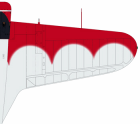
 ..... .....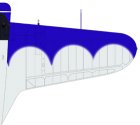
 ..... .....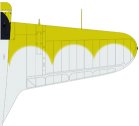 |
These three absolutely wonderful I-16 Type 5s were finished for the 1937 May Day Parade festivities in Moscow. The pilots of these machines were Chkalov (Red), Suprun (Blue), and Stefanovski (Yellow), perhaps the three greatest fliers in the USSR.
These aircraft were in fact standard Type 5 series military machines, each taken directly from the production lines at Zavod 21. The factory finish was probably AEh-9 grey over-all with an AEh-11 Black engine cowling, as was typical at this time. The three machines were then given a beautiful trim color application over this scheme, each in one of the primary colors of red/blue/yellow. The spinners were painted white, were highly polished, and carried a large red five-pointed star on the tip. The machines retained their plain red star national markings on the wing undersurface, but not on the uppers nor fuselage sides.
These three machines and their gifted pilots put on what observers have recalled as the greatest flying exhibition in the history of aviation. During the middle of the May Day parade, these aircraft appeared over Red Square in formation, connected one to each other by a five meter long piece of red ribbon. In this fashion, Chkalov, Suprun, and Stefanovski performed all manner of intensive aerobatics--loops, slow barrel rolls, inverted flight, and much more--in formation, never once breaking the ribbon between them. Indeed, the performance was so astounding that the entire event was apparently brought to a halt as all on-lookers below became transfixed by the three gorgeous aircraft in such improbable flight. The demonstration concluded with a roaring low-level pass over St.Basel's to the thundering applause of the crowds below.
As a further tribute to this unique display, all subsequent Red Army acrobatic teams finished their demonstration machines in a manner very similar to the pattern established by these aircraft, as can be seen in countless photographs from 1937-38 onwards. The fate of these three beauties after the 1937 Parade are alas unknown, and no further information about them exists after that time. A stupendous photograph with all three machines and their pilots resides in the collection of the Tsentralniy Dom Aviatsia i Kosmonavtika, Moscow.